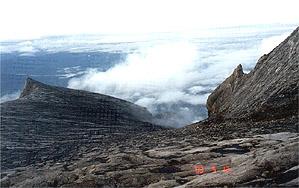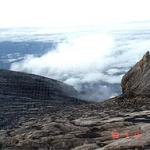Peeping over South East Asia world heritage
"It is back, that incredible backdrop of teeth and fangs, gulley, precipice, cliff, plateau, gorge, peak, projectile, point - you name it, Kinabalu has it, up there above you, black and tense, looking as if forged in iron and dropped into place as a vast casting. Surely this is the most complete statement of 'I am a Mountain' made anywhere on this earth." - Tom Harrison, Frontispiece to Kinabalu Summit of Borneo, 1978 Local natives once found this mountain an eerie place. It was believe that the spirits of the Kadazandusun ancestors dwell on this mountain, repelling anyone from exploring it hundreds of years back. The belief still stands today for 'Akinabalu', the revered place of the dead. This is an impressive mountain of magnificent characters, enchanting its successful conquerors with its massive granite excursion which is still rising about 5mm every year. Being the youngest non-volcanic mountain between mainland South East Asia and New Guinea, Mount Kinabalu in Sabah stands proud to proclaim the highest peak of South East Asia at 4,095.2 meters. The first documented ascent was recorded by Sir Hugh Low, a British officer in 1851 after a compromise with the locals with the obligatory ceremony of sacrificing 7 white chickens and offerings of eggs prayers to appease the spirits prior to the climb attempt. Today, declared as one of the world prestigious heritage, people from around the world flock to Sabah to see the wonder of its remnant peaks and pinnacles carved by ice escape grinding 9 million years ago. 10,000 years ago, ice caps still covered the submit area with tropical rainforest just miles below. The evidence of glaciations such as striation, crescent gorge and shattered marks is grandeur enough to ooze me out from Kuala Lumpur city to see it with my own eyes and to feel the pride and joy of standing at the top of South East Asia. Together with my three colleagues, we were all set to take the challenge to conquer Mount Kinabalu. The only fear lurking was the unkind weather that might withhold our climb to the summit from Laban Rata. Our worst fear started as soon as the plane landed on Kota Kinabalu airport. Yep, we were greeted with drizzling rain. Somehow we managed to persuade the kind cab driver to send us shopping for ponchos before adjourning to Kinabalu National Park. He too went shopping at the fish market and so the journey to the park that took 2 hours drive was accompanied by an unpalatable fishy smell. Bountiful pictures of flowing mountains adorned both side of our glances through the dripping wet window as we passed Menggatal, Tepilok and Tuaran heading towards Ranau town. Fogs appeared now and then hiding the fertile slopes of Kinabalu where villages of Kadazandusun - Sabah's largest ethnic community, scattered randomly. Air was chilly upon reaching the Kinabalu Park that was established in 1964 covering an area of 753.7 sq. After dumping our backpack at the Mengilan hostel and greeted two Swedish and two Germans who shared room with us, we were off to check out Silau-silau trail and the Mountain Garden. Silau-silau trail introduced my ignorance knowledge with its endemic plant - e.g: the pitcher plant (Nephenses Rajah) - a modified plant with sugary fragrance in its outer layer to attract insects for additional nutrition. Varieties of orchids could be seen along the way, also wild berries and the sexy nude tree that has curative value for coughing, fever, sore throat and even use as eye drop by locals. Its burnt skin can be used to shield off mosquitoes apparently. Monday morning came by. The sun was in its benevolent mood, giving us hope of a good weather climb to Laban Rata as we took our first step on Mesilau trail together with our guide, Biling and two Singaporean friends we met earlier on, Terry and Kit. The trail is naturally categorized layer by layer presenting different wonderful vegetation zones of the park. Large amount of creeping plants, terrestrial orchids, ferns and mosses greeted our view at the lower montane forest (1900m - 2700m in altitude). Over 6000 species of vascular plant and no less than 145 families of flowering plants grow in the park where the differences in vegetation are determined by type of bed rocks, type of soils, altitudinal and varying local climate condition. As we move in a slow and steady pace, the undulating path didn't seem to be arduous after a while. After crossing a hanging bridge and a light entertainment of Irizan's rolling down the damp rainforest floor, the weather deluged us with rain and a flurry of wind. There we were, trapped in our trendy ponchos holding our sturdy walking stick looking much like witches in the wild. We had then passed the mossy world of drifting clouds and entering into the bonsai world at the upper elevation. Draped in light green fluffy cotton-like plant, the bonsai trees look stunning with the surrounding swirling clouds as their backdrop. The random Mesilau trail soon meets the Timpohon trail at Layang-Layang (place of swallows) after 4 hours. Vegetations began to thin and we reached the Laban Rata resthouse soon after. The hike was not difficult after all, more to a treacherous climb to my relief. Our tummy was drumming as we rushed to the kitchen and had an absolutely ravenous time devouring the highly-priced fried rice over a hot Milo drink. It was a cut throat price at RM10 per plate but then again when we get to see the agile porters (even woman) carrying gas tank and ample of food that can reach 30kg up the trail everyday, we paid willingly at the thought of their effort and superb strength! All excited for the early dawn climb at 3am, we sought the great oblivion of sleep after the gorging moment. Procession of climbers trudged higher and higher as the awaited journey to Low's peak started. Ladders, hand railings and ropes for steeper part help to ease the climb. A mistake or slip would have cost a fall or twisted ankle for sure as I looked down the boulders I'd hauled up. The moonlight shone on the bare granite slabs that stretch endlessly ahead giving it an eerie moonscape as the altitude became higher. Thinning air soon slowed down several climbers whom began to feel the effect of altitude sickness of nausea and difficulty in breathing. Ironically, I was relatively feeling energized pacing up my speed crossing the granite plateau and jumping up once a while at the sight of over-grown rats in between the crevices. They are incredibly huge! How on earth did they manage to survive in this cold weather with no food supply, I barely understand. The two hours climb presented me with an achievement of pride and joy when I finally stepped on the highest standing rock of South East Asia, the Low's Peak. About 10 people were already there out of roughly 150 climbers, waiting for the spectacular sunrise. Clouds shrouded down below and far end as I looked out with awe the creation of Mother Earth, one of the world best kept heritage teeming with splendours. Like a peek-a-boo, the demure light of the sun penetrates through the fluffy snow-white clouds. Oozing over the horizon, it shoved aside darkness and crept along the massive granite surface. It would have been an awesome sunrise during clearer days, but again the cloudy sunrise was great enough to herald our success in conquering the impressive Mount Kinabalu itself. The vantage point at the edge previewed a dramatic drop of 1,000 meters down when the great swell of clouds billowed out from the deep spooky gully, the Low's Gully. A chasm stretching 16km in length, it separates the summit plateau into western and eastern plateau. The U-shaped valley formed by movement of ice thousands of years ago was embroidered with views of St.John's Peak, Ugly Sister's Peak, Donkey Ear's peak, South Peak, King Edward's Peak and Oyayubi Iwu Peak. Shrubby plants and tough grasses grow in sunken places and crevices far below. With all of that beauty etched in my memories, the abiding journey completed my climb just the way Oscar Cook (1927) had experienced it - "An eerie and fantastic walk and one to breed wild flights of fancy and dream".
 ThingsAsian
ThingsAsian















